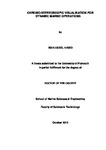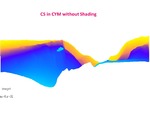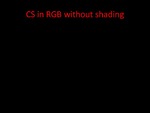Chromo-Stereoscopic Visualisation For Dynamic Marine Operations
| dc.contributor.supervisor | ABBOTT, VICTOR J | |
| dc.contributor.author | ABDEL HAMID, IMAN | |
| dc.contributor.other | Faculty of Science and Engineering | en_US |
| dc.date.accessioned | 2012-12-12T15:58:25Z | |
| dc.date.available | 2012-12-12T15:58:25Z | |
| dc.date.issued | 2012 | |
| dc.date.issued | 2012 | |
| dc.identifier | 10114066 | en_US |
| dc.identifier.uri | http://hdl.handle.net/10026.1/1240 | |
| dc.description.abstract |
Chromo stereoscopy (CS) is a simple and cost effective 3D system that can easily deliver geospatial information. CS has been used in several scientific data presentations, including remote sensing, physical modelling and hydrographic applications. In some of these applications the 3D effect was solely CS-related, while others integrated CS with other methods of implementing 3D. CS was mainly used in static visualisation, but no dynamic applications were found. Also, the restricted use of colour was acknowledged as a limitation for CS suggesting its unsuitability for applications where colour conventions are significant. This research focuses on CS for the marine applications and aims to (i) investigate users’ perception to CS effect and its interaction with other depth cues, (ii) assess the acceptance of the potential users to the changes in conventional colouring systems, (iii) and evaluate the usability and practicality of CS as an additional visualisation system in dynamic marine applications. To address these, visual scenarios were developed and expert human participants were recruited and interview for the evaluation. CS was well perceived among the participants. The interaction between different depth cues has advantages of increasing the depth perception and comprehending the 3D nature of the surrounding environment. For instance, from a certain view angle where two objects block each other, CS enhances the interposition effect, that indicates which object is in the front and gives a qualitative estimation of the spatial separation between them. Shading increases the realism of surface objects, and provides information for their undulation. It also dilutes the colours used in CS and increases the range of colours perceived and enhances the effect perceived from CS. The advantage of using the colour coding system to indicate distance is a valuable and original outcome of this thesis. This coding improved the participants understanding of the behaviour of moving objects (whether vessels coming closer or drifting apart) and enabled users to locate them in reference to the surrounding topography. Such knowledge is important to attain safer operations in a 3D environment. Accepting changes in colours in a visual presentation is linked to experience gained during interaction with the system, and the changes would be tolerated by the users in favour of improvements in situation awareness. Blind navigation and underwater operations are examples of where CS can be beneficial. | en_US |
| dc.language.iso | en | en_US |
| dc.publisher | University of Plymouth | en_US |
| dc.subject | Chromostereoscopy | en_US |
| dc.subject | Marine Visualisation | en_US |
| dc.subject | Users | en_US |
| dc.subject | Cartographic Conventions | en_US |
| dc.title | Chromo-Stereoscopic Visualisation For Dynamic Marine Operations | en_US |
| dc.type | Thesis | |
| plymouth.version | Edited version | en_US |
| dc.identifier.doi | http://dx.doi.org/10.24382/4106 |
Files in this item
This item appears in the following Collection(s)
-
01 Research Theses Main Collection
Research Theses Main




